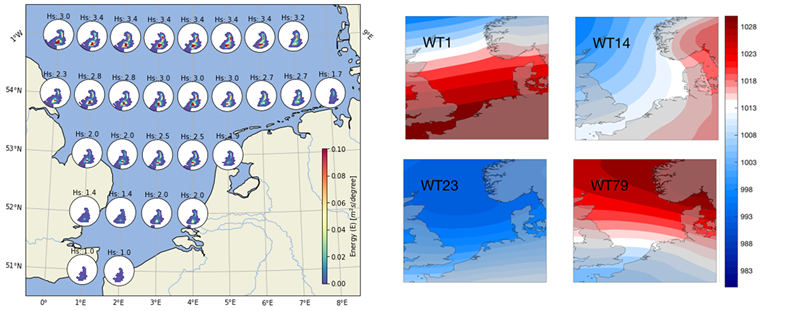C.D. Hoogervorst1, *, J. A. A. Antolínez1,, J. Portilla-Yandún2, S.G.J Aarninkhof1, M. Tissier1
1 Delft University of Technology; 2 Escuela Politécnica Nacional
*corresponding author:
Introduction
Simplified parameters are commonly used to describe wave conditions and related coastal processes, such as wave breaking, sediment transport, and wave dissipation. These parameterizations often assume unimodal wave conditions and therefore do not account for coexisting waves that might be related to different meteorological events. The use of generalized wave parameters in multimodal wave conditions in coastal engineering practices leads to uncertainties in wind-wave climate assessments of coastal activities, risk management, and the decision-making of long-term multidecadal coastal strategies that rely on wave climate data (Portilla et al., 2015). This study analyses the importance and application of considering coexisting wave trains.
Methods
The wave trains in the North Sea and the Dutch shoreface are analyzed by spectral wave partitions and wave families (Portilla et al., 2015). In parallel, the spatio-temporal statistics of the wave spectrum are investigated using statistical and machine learning methods to spatially group wave families and to analyze the spatio-temporal variability of the wave climate. Finally, the wave families and characteristic wave conditions are linked with atmospheric patterns, drivers of the wind-generated waves.
Results
On the Dutch shoreface, multimodal wave conditions occur 65% of the time, wherein the angle between wave trains is less than 60 degrees for 39% of the time and greater than 120 degrees 17% of the time. The wave families show the cross-shore development of waves within a specific domain in the frequency-directional spectrum. Relating wave families in a deterministic way is intricate and time-consuming, here we cluster them through machine-learning techniques which is consistent in cases of small spatial domains. Clustering similar wave conditions over time gives additional insight into the temporal-spatial variability of the wave climate, including distinct statistics about wave partitions, families, and sediment transport. The relation with weather conditions shows that waves crossing at an angle of about 90 degrees can be generated with one high- or low-pressure system and are potentially capable of transporting a lot of wave-driven sediment transport, which is hard to accurately predict with state-of-the-art methods.

Figure 1: Left: The representative frequency-directional spectra for a specific (grouped) wave condition. The radial axis describes the wave period, with short perioded waves in the center, the angular axis the wave propagation direction, and the Significant wave heights are based on all the wave energy. Right: The sea level pressure for four characteristic weather conditions.
References
Portilla-Yandún, J., Cavaleri, L., & Van Vledder, G. P. (2015). Wave spectra partitioning and long term statistical distribution. Ocean Modelling, 96, 148–160. https://doi.org/10.1016/j.ocemod.2015.06.008
I. Surname1*, F.N. Another-Surname2 , Y. Next-Surname2
1 University Name, Country; 2 Organization Name, Country
* Corresponding author: mail.name@organization.org


